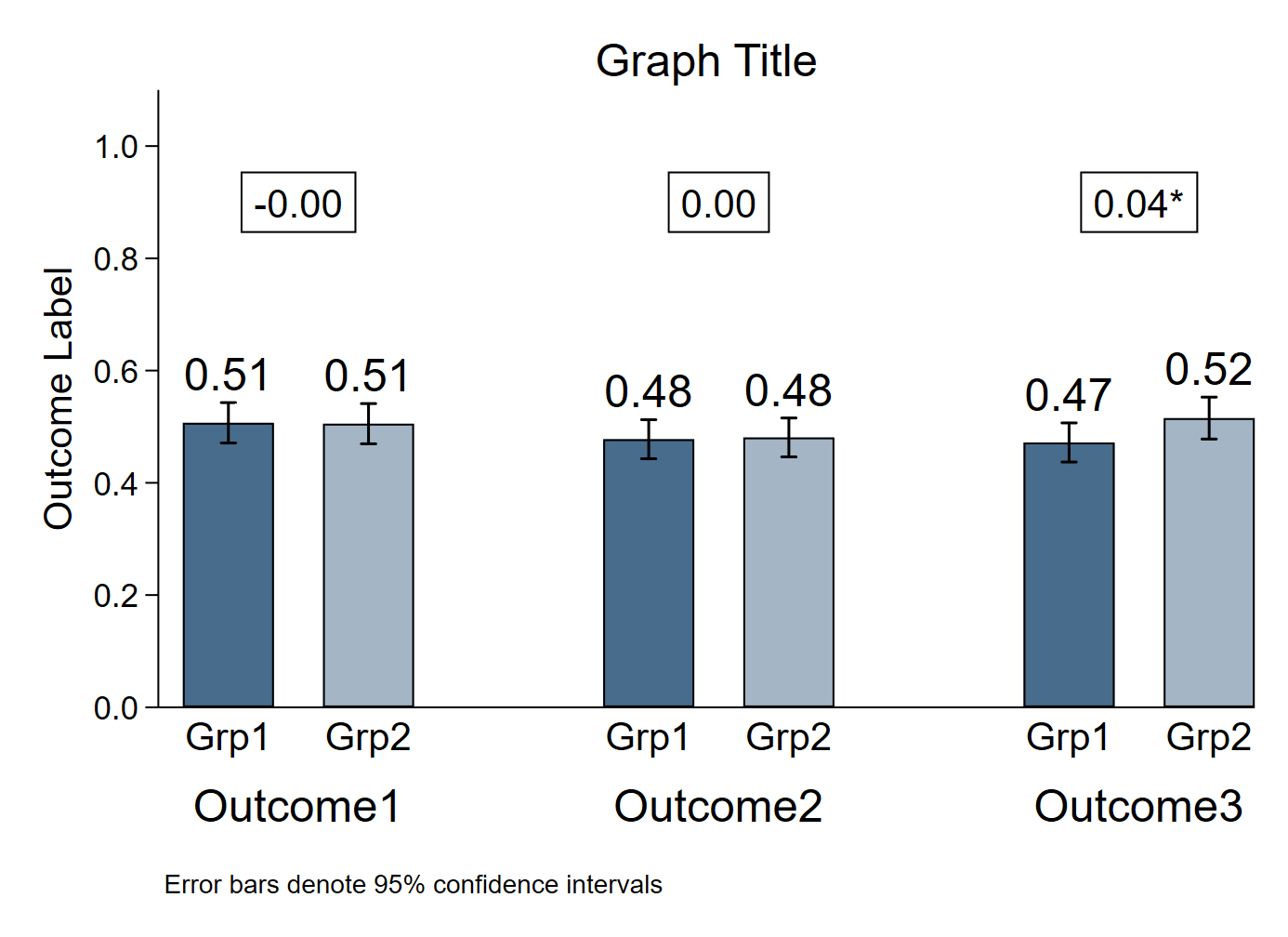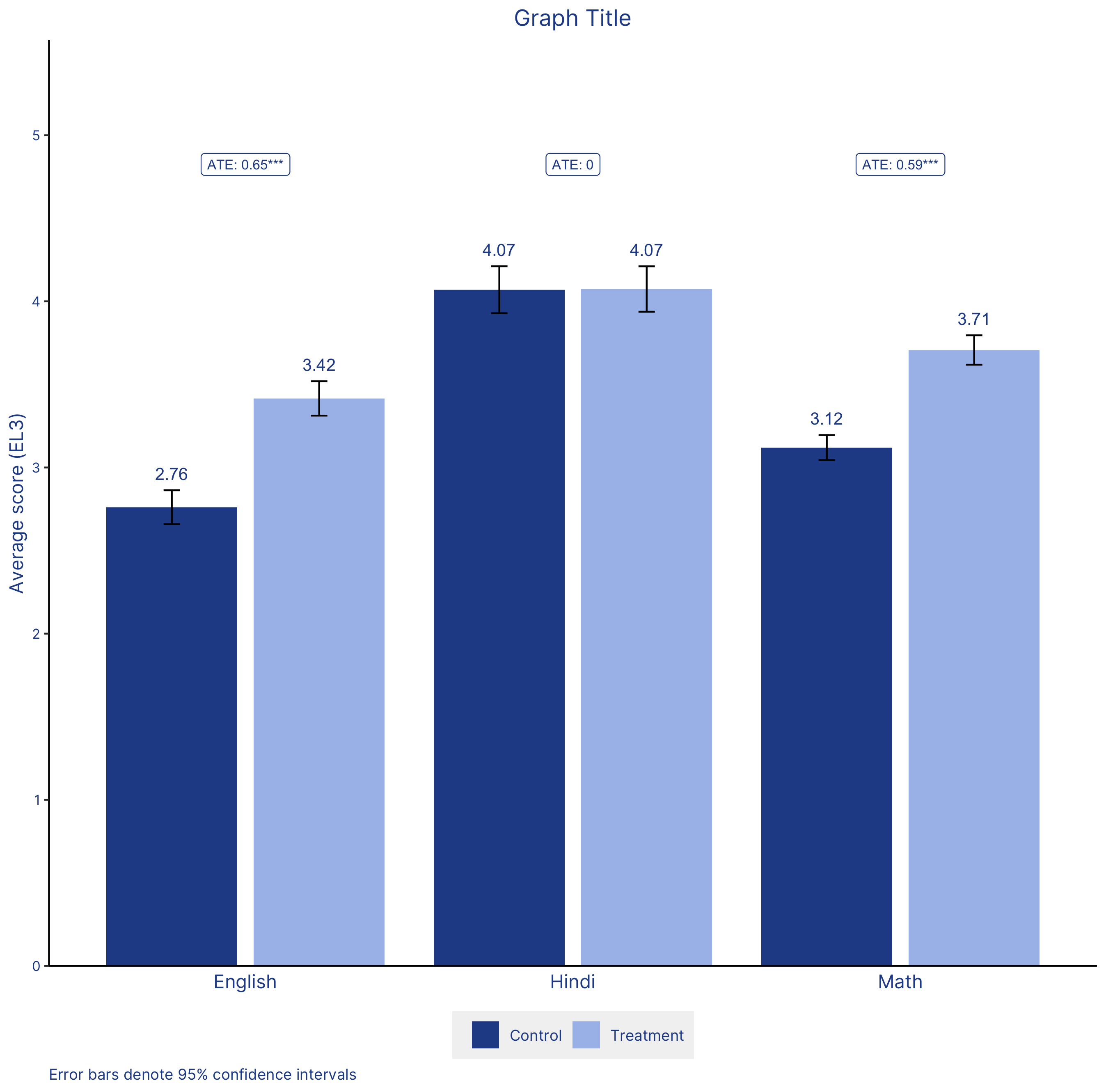The chart
Stata

R

Data
Dataset used to create the R version of the graph can be found here.
The code
Stata
* Create fake dataset (delete this section and import your own data)
clear
set obs 500
forval i = 1/3{
gen outcome_var`i' = runiform()
}
gen group_var = (_n > 0.5*_N)
* Enter your relevant variable names here
local outcome1 outcome_var1
local outcome2 outcome_var2
local outcome3 outcome_var3
local group group_var
* Change the graph font here if you want
// graph set window fontface "Times New Roman"
* Create variables for graph
gen xaxis = _n in 1/8
gen group1 = 0 if (_n == 1 | _n == 4 | _n == 7)
replace group1 = 1 if (_n == 2 | _n == 5 | _n == 8)
gen means = .
gen ci_high = .
gen ci_low = .
* Calculate means, CIs
local j 1
forval i = 1/3{
* Group 1 values
mean `outcome`i'' if `group' == 0
matrix A = r(table)
replace means = A[1,1] in `j'
replace ci_low = A[5,1] in `j'
replace ci_high = A[6,1] in `j'
local ++j
* Group 2 values
mean `outcome`i'' if `group' == 1
matrix A = r(table)
replace means = A[1,1] in `j'
replace ci_low = A[5,1] in `j'
replace ci_high = A[6,1] in `j'
local ++j
local ++j
* ATE
reg `outcome`i'' `group', robust
matrix A = r(table)
local ate`i' = A[1,1]
local ate`i': disp %3.2f `ate`i''
local pval = A[4,1]
if `pval' < 0.1{
local pval_stars`i' *
}
if `pval' < 0.05{
local pval_stars`i' **
}
if `pval' < 0.01{
local pval_stars`i' ***
}
}
* Format labels for bar heights
format %3.2f means
* Graph
twoway (bar means xaxis if group1 == 0, fcolor(navy) lcolor(black) barwidth(0.65)) ///
(bar means xaxis if group1 == 1, fcolor(navy*0.5) lcolor(black) barwidth(0.65)) ///
(rcap ci_high ci_low xaxis, lcolor(black)) ///
(scatter ci_high xaxis, msymbol(none) mlabel(means) mlabsize(large) mlabcolor(black) mlabposition(12)) ///
, ///
text(0.9 1.5 "`ate1'`pval_stars1'", box fcolor(none) lcolor(black) size(medlarge) margin(small)) ///
text(0.9 4.5 "`ate2'`pval_stars2'", box fcolor(none) lcolor(black) size(medlarge) margin(small)) ///
text(0.9 7.5 "`ate3'`pval_stars3'", box fcolor(none) lcolor(black) size(medlarge) margin(small)) ///
xtitle(" ") ///
xlabel(1 "Grp1" 2 "Grp2" 4 "Grp1" 5 "Grp2" 7 "Grp1" 8 "Grp2", labsize(medlarge) notick) ///
xmlabel(1.5 "Outcome1" 4.5 "Outcome2" 7.5 "Outcome3", labsize(large) notick labgap(*11)) ///
xscale(range(0.5 2.5)) ///
ylabel(0(0.2)1, format(%3.1f) angle(horizontal)) ///
yscale(range(0 1.1)) ///
ytitle("Outcome Label", size(medlarge)) ///
title("Graph Title") ///
note("Error bars denote 95% confidence intervals") ///
legend(off) ///
scheme(s1color) ///
plotregion(margin(zero) style(none))
graph export "Bar graph with CIs_2 groups 3 outcomes.png", replace
R
# Bar graph with CIs - 2 groups and 3 outcomes
############################### Initial Setup ##################################
# Install required packages if they are not already in your system
packages <- c('tidyverse')
lapply(packages, function(i) {if(!i %in% installed.packages() == T) {install.packages(i, dependencies = TRUE, repos='http://cran.rstudio.com/')}})
# Loading required packages
library("tidyverse")
# Setting working directory
setwd("~/Dropbox (IDinsight)/Data visualization library")
############################### Loading dataset ################################
# Loading EG DIB dataset in csv format
mydata <- read_csv("Data/EG_DIB.csv, show_col_types = FALSE")
############################### Data processing ################################
# The 2 groups will be given by the treatment status - control and treatment
# Variable: treatment
# The 3 outcomes are endline 3 English, Math and Hindi test scores
# Variables: math_ely3_villavg english_ely3_villavg hindi_ely3_villavg
# Converting the treatment variable to a factor(categorical) variable
# This is because treatment will appear on the x-axis and it has only 2
# values (discrete)
mydata$treatment <- as.factor(mydata$treatment)
# The dataset is currently in wide format. Each row is an individual village.
# We need to transform this to a long format. The target dataset will have
# columns to indicate:
# 1. Village
# 2. Treatment status
# 3. Subject (Math/Hindi/English)
# 4. Score
mydata_long <- mydata %>%
select(village_id_rand, treatment, hindi_ely3_villavg, english_ely3_villavg,
math_ely3_villavg) %>%
gather(key = "subject", value = "score", 3:5) %>%
arrange(village_id_rand)
# cleaning up the subject column
mydata_long$subject <- str_sub(mydata_long$subject, end = -14)
# Creating the means, CIs and ATE
# Assuming 95% CI
alpha = 0.05
# Creating means and CI and storing in my_sum tibble
my_sum <- mydata_long %>%
group_by(treatment, subject) %>%
summarise(n = n(),
mean = mean(score, na.rm = T),
sd = sd(score, na.rm = T)) %>%
mutate(se = sd/sqrt(n)) %>%
mutate(ic = se * qt((1-alpha)/2 + 0.5, n - 1))
# Creating the ATEs and p-value stars indicating significance
subjects <- vector()
ates <- vector()
p_stars <- vector()
counter <- 1
# Running the regression model for each subject
for(i in levels(as.factor(mydata_long$subject))) {
model <- lm(score ~ treatment, data = filter(mydata_long, subject == i))
# Storing the subject
subjects[counter] <- i
# Storing the ATE
ates[counter] <- summary(model)$coefficients[2,1]
# Storing the p value
p_value <- summary(model)$coefficients[2,4]
# Creating a variable to store the significance stars
if(p_value < 0.01) {
p_stars[counter] = "***"
} else if (p_value < 0.05) {
p_stars[counter] = "**"
} else if (p_value < 0.1) {
p_stars[counter] = "*"
} else {
p_stars[counter] = ""
}
counter = counter + 1
}
# Creating a tibble with the subject, ATE and significance stars
ate_df <- tibble(subjects, ates, p_stars)
############################### Creating the graph #############################
# Define axis and fill variable
x_values <- my_sum$subject
y_values <- my_sum$mean
fill_by <- my_sum$treatment
plot <- my_sum %>%
# Setting aesthetics which will be inherited by other geometric objects
ggplot(aes(x = x_values, y = y_values, fill = fill_by)) +
# Position dodge applied so that the bars are not superimposed
geom_bar(stat = "identity", position = position_dodge(width = 0.9),
width = 0.8) +
# Changing the bar colors according to IDinsight colors
scale_fill_manual(values = c("#264D96", "#A8BFEB"),
labels = c("Control", "Treatment")) +
# Changing x-axis labels to capitalize subject name
scale_x_discrete(labels = c("English", "Hindi", "Math")) +
# Adding Error bars
# As with geom_bar, position dodge has been applied here as well so that the
# error bars are not superimposed
geom_errorbar(aes(ymin = y_values - ic, ymax = y_values + ic),
width = 0.1,
size = 0.5,
position = position_dodge(width = 0.9)) +
##>>> rounding the lables to two decimals
# Adding text to display the mean of each bar. It is placed 0.1 units above
# (mean + ic)
geom_text(aes(y = y_values + ic + 0.1,
label = round(y_values, 2)),
size = 3.5,
color = "#264D96",
position = position_dodge(width = 0.9)) +
# Setting the limits of the y-axis. The expand function with (0, 0) removes
# the gap between the data the axis
scale_y_continuous(expand = c(0, 0),
limits = c(0, max(y_values) + 1.5)) +
# Annotation for the 3 ATEs
# Please note that this can be made into a single annotate layer through the
# following format:
# annotate(geom = "label", x = 1:2, y = 20:21, label = c("label 1", "label 2"))
annotate(geom = "label", x = 1, y = (max(y_values) + 0.75),
label = paste0("ATE: ",
round(ate_df$ates[ate_df$subjects == "english"], digits = 2),
ate_df$p_stars[ate_df$subjects == "english"]),
size = 2.8,
color = "#264D96") +
annotate(geom = "label", x = 2, y = (max(y_values) + 0.75),
label = paste0("ATE: ",
round(ate_df$ates[ate_df$subjects == "hindi"], digits = 2),
ate_df$p_stars[ate_df$subjects == "hindi"]),
size = 2.8,
color = "#264D96") +
annotate(geom = "label", x = 3, y = (max(y_values) + 0.75),
label = paste0("ATE: ",
round(ate_df$ates[ate_df$subjects == "math"], digits = 2),
ate_df$p_stars[ate_df$subjects == "math"]),
size = 2.8,
color = "#264D96") +
# Creating graph title, axis title and caption
labs(title = "Graph Title",
y = "Average score (EL3)",
caption = "Error bars denote 95% confidence intervals")
############################# Formatting the graph #############################
plot +
theme_classic() +
# The following visual changes have been made:
# Changed the font family to Inter
# Legend title has been removed
# Legend box has been moved to the bottom of the plot
# Legend text has been modified
# Legend box background color has been changed to a very light gray
# Plot title font has been changed
# Plot caption font has been changed and left aligned
# X-axis title has been removed
# Y-axis title font color has been changed
# X-axis text color and size has been changed
# X-axis ticks have been removed
# Y-axis text size and color has been changed
theme(text = element_text(family = "Inter"),
legend.title = element_blank(),
legend.position = "bottom",
legend.text = element_text(color = "#264D96"),
legend.background = element_rect(fill = "gray95", size = 0.25,
linetype = "dotted"),
plot.title = element_text(hjust = 0.5, color = "#264D96"),
plot.caption = element_text(hjust = 0, color = "#264D96"),
axis.title.x = element_blank(),
axis.title.y = element_text(color = "#264D96"),
axis.text.x = element_text(size = 11, color = "#264D96"),
axis.ticks.x = element_blank(),
axis.text.y = element_text(size = 8, color = "#264D96"))
############################## Saving and exporting ############################
# Indicating the export folder and the image file name
export_folder <- "R/Bar graphs/Exports/"
img_name <- "bar_graph_ci_3_outcomes_R_reviewed.png"
ggsave(paste(export_folder, img_name,sep = ""))
Other details
R
Code written by Arkadeep Bandyopadhyay and reviewed by Sandra Alemayehu.
Colors for the graph have been selected from IDinsight’s brand guide.